实验二 跟踪分析Linux内核5.0系统调用处理过程
实验二 跟踪分析Linux内核5.0系统调用处理过程
学号293 原创作品转载请注明出处 https://github.com/mengning/linuxkernel/
实验要求
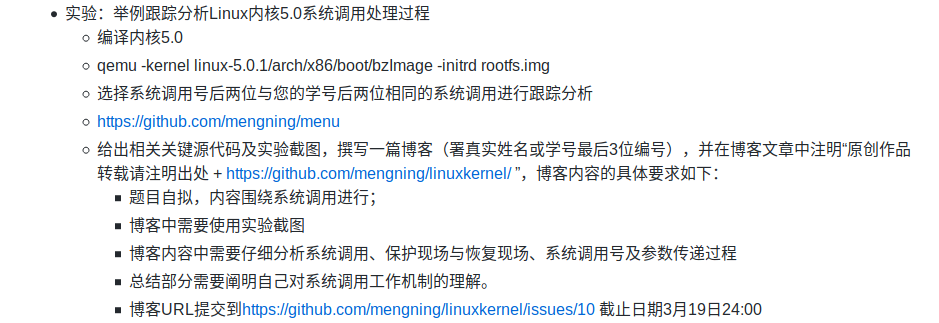
实验环境
Ubuntu 18.04 LTS
gcc 7.3.0
实验步骤
1. 下载内核代码并编译
可以直接下载后然后手动解压
也可以按照以下方式下载解压
mkdir ~/LinuxKernel
cd ~/LinuxKernel
wget https://cdn.kernel.org/pub/linux/kernel/v5.x/linux-5.0.1.tar.xz
xz -d linux-5.0.1.tar.xz
tar -xvf linux-5.0.1.tar
cd linux-5.0.1
然后安装内核编译工具,(可以考虑换源为国内的,参考)
sudo apt install build-essential flex bison libssl-dev libelf-dev libncurses-dev
然后
make menuconfig
选择kernel hacking -> Compile-time checks and compiler options -> [*]compile the kernel with debug info
再make
make -j8

此时已经编译完成,生成的文件地址在 ./arch/x86/boot/bzImage
2.制作根文件系统
cd ~/LinuxKernel
mkdir rootfs
git clone https://github.com/mengning/menu.git
cd menu
sudo apt install gcc-multilib #不安装,编译时会提示缺少文件,实际上是安装gcc环境不完善导致
gcc -pthread -o init linktable.c menu.c test.c -m32 -static
cd ../rootfs
cp ../menu/init ./
find . | cpio -o -Hnewc |gzip -9 > ../rootfs.img

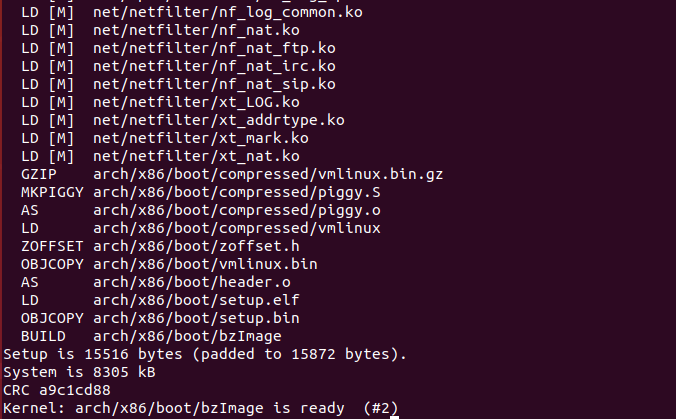
3.启动MenuOS
qemu-system-i386 -kernel linux-5.0.1/arch/x86/boot/bzImage -initrd rootfs.img
此时显示


尽管我已经装了qemu-system-i386
然后

我于是采用建议下载了qemu-system-x86,这里主要是因为我编译内核时编译的时64位的版本所以不能用
也可以通过重新make i386_defconfig 解决,但是这样在之后的gdb过程中,无法显示断点所在的文件与行数
所以这里我重新使用make menuconfig,去掉勾选64-bit kernel,同时勾选Kernel hacking -> Compile-time checks and compiler options -> Compile the kernel with debug info 使编译成32位的内核并且能方便显示文件位置
再编译
make -j8
此时需要重新生成rootfs.img,为了方便我这里直接修改Makefile中的设置为

然后进行编译
cd ~/LinuxKernel/menu
make rootfs
得到
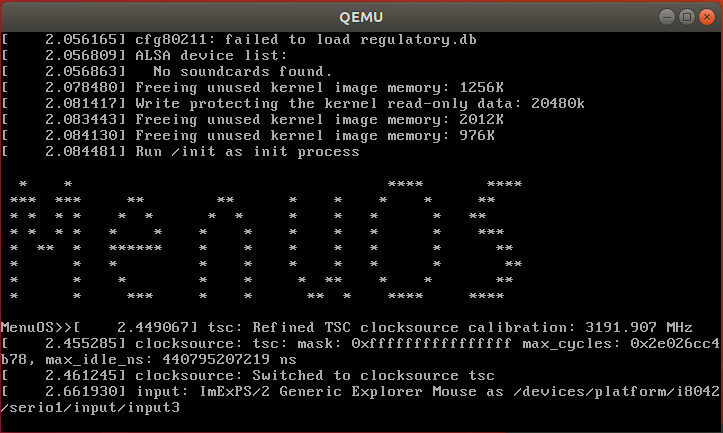
4.调试跟踪内核启动
cd ..
qemu-system-i386 -kernel linux-5.0.1/arch/x86/boot/bzImage -initrd rootfs.img -S -s -append nokaslr
注意:-append nokaslr选项的说明见知乎。
运行qemu虚拟机后,在当前目录新建一个终端窗口,运行下列命令:
cd linux-5.0
gdb vmlinux
进入gdb界面后连接到qemu,输入
target remote:1234
然后即可正常的进行debug了

5 代码分析
几乎所有的内核模块均会在start_kernel进行初始化.在start_kernel中,会对各项硬件设备进行初始化,包括一些page_address、tick等等,直到最后需要执行的rest_init中,会开始让系统跑起来。
然后在rest_init()过程中,会调用kernel_thread()来创建内核线程kernel_init,它创建用户的init进程,初始化内核,并设置成1号进程,这个进程会继续做相关的系统的初始化。
然后,start_kernel 会调用kernel_thread 并创建kthreadd,负责管理内核中得所有线程,然后进程ID会被设置为2。
最后,会创建idle进程(0号进程),不能被调度,并利用循环来不断调号空闲的CPU时间片,并且从不返回。
参考自:pianogirl123
void __init __weak arch_call_rest_init(void)
{
rest_init();
}
asmlinkage __visible void __init start_kernel(void)
{
char *command_line;
char *after_dashes;
set_task_stack_end_magic(&init_task);
smp_setup_processor_id();
debug_objects_early_init();
cgroup_init_early();
local_irq_disable();
early_boot_irqs_disabled = true;
/*
* Interrupts are still disabled. Do necessary setups, then
* enable them.
*/
boot_cpu_init();
page_address_init();
pr_notice("%s", linux_banner);
setup_arch(&command_line);
/*
* Set up the the initial canary and entropy after arch
* and after adding latent and command line entropy.
*/
add_latent_entropy();
add_device_randomness(command_line, strlen(command_line));
boot_init_stack_canary();
mm_init_cpumask(&init_mm);
setup_command_line(command_line);
setup_nr_cpu_ids();
setup_per_cpu_areas();
smp_prepare_boot_cpu(); /* arch-specific boot-cpu hooks */
boot_cpu_hotplug_init();
build_all_zonelists(NULL);
page_alloc_init();
pr_notice("Kernel command line: %s\n", boot_command_line);
parse_early_param();
after_dashes = parse_args("Booting kernel",
static_command_line, __start___param,
__stop___param - __start___param,
-1, -1, NULL, &unknown_bootoption);
if (!IS_ERR_OR_NULL(after_dashes))
parse_args("Setting init args", after_dashes, NULL, 0, -1, -1,
NULL, set_init_arg);
jump_label_init();
/*
* These use large bootmem allocations and must precede
* kmem_cache_init()
*/
setup_log_buf(0);
vfs_caches_init_early();
sort_main_extable();
trap_init();
mm_init();
ftrace_init();
/* trace_printk can be enabled here */
early_trace_init();
/*
* Set up the scheduler prior starting any interrupts (such as the
* timer interrupt). Full topology setup happens at smp_init()
* time - but meanwhile we still have a functioning scheduler.
*/
sched_init();
/*
* Disable preemption - early bootup scheduling is extremely
* fragile until we cpu_idle() for the first time.
*/
preempt_disable();
if (WARN(!irqs_disabled(),
"Interrupts were enabled *very* early, fixing it\n"))
local_irq_disable();
radix_tree_init();
/*
* Set up housekeeping before setting up workqueues to allow the unbound
* workqueue to take non-housekeeping into account.
*/
housekeeping_init();
/*
* Allow workqueue creation and work item queueing/cancelling
* early. Work item execution depends on kthreads and starts after
* workqueue_init().
*/
workqueue_init_early();
rcu_init();
/* Trace events are available after this */
trace_init();
if (initcall_debug)
initcall_debug_enable();
context_tracking_init();
/* init some links before init_ISA_irqs() */
early_irq_init();
init_IRQ();
tick_init();
rcu_init_nohz();
init_timers();
hrtimers_init();
softirq_init();
timekeeping_init();
time_init();
printk_safe_init();
perf_event_init();
profile_init();
call_function_init();
WARN(!irqs_disabled(), "Interrupts were enabled early\n");
early_boot_irqs_disabled = false;
local_irq_enable();
kmem_cache_init_late();
/*
* HACK ALERT! This is early. We're enabling the console before
* we've done PCI setups etc, and console_init() must be aware of
* this. But we do want output early, in case something goes wrong.
*/
console_init();
if (panic_later)
panic("Too many boot %s vars at `%s'", panic_later,
panic_param);
lockdep_init();
/*
* Need to run this when irqs are enabled, because it wants
* to self-test [hard/soft]-irqs on/off lock inversion bugs
* too:
*/
locking_selftest();
/*
* This needs to be called before any devices perform DMA
* operations that might use the SWIOTLB bounce buffers. It will
* mark the bounce buffers as decrypted so that their usage will
* not cause "plain-text" data to be decrypted when accessed.
*/
mem_encrypt_init();
#ifdef CONFIG_BLK_DEV_INITRD
if (initrd_start && !initrd_below_start_ok &&
page_to_pfn(virt_to_page((void *)initrd_start)) < min_low_pfn) {
pr_crit("initrd overwritten (0x%08lx < 0x%08lx) - disabling it.\n",
page_to_pfn(virt_to_page((void *)initrd_start)),
min_low_pfn);
initrd_start = 0;
}
#endif
kmemleak_init();
setup_per_cpu_pageset();
numa_policy_init();
acpi_early_init();
if (late_time_init)
late_time_init();
sched_clock_init();
calibrate_delay();
pid_idr_init();
anon_vma_init();
#ifdef CONFIG_X86
if (efi_enabled(EFI_RUNTIME_SERVICES))
efi_enter_virtual_mode();
#endif
thread_stack_cache_init();
cred_init();
fork_init();
proc_caches_init();
uts_ns_init();
buffer_init();
key_init();
security_init();
dbg_late_init();
vfs_caches_init();
pagecache_init();
signals_init();
seq_file_init();
proc_root_init();
nsfs_init();
cpuset_init();
cgroup_init();
taskstats_init_early();
delayacct_init();
check_bugs();
acpi_subsystem_init();
arch_post_acpi_subsys_init();
sfi_init_late();
/* Do the rest non-__init'ed, we're now alive */
arch_call_rest_init(); //调用rest_init()
}
rest_init() 函数
void rest_init(void)
{
int pid;
………………
kernel_thread(kernel_init, NULL, CLONE_FS);
numa_default_policy();
pid = kernel_thread(kthreadd, NULL, CLONE_FS | CLONE_FILES);
rcu_read_lock();
kthreadd_task = find_task_by_pid_ns(pid, &init_pid_ns);
rcu_read_unlock();
complete(&kthreadd_done);
init_idle_bootup_task(current);
schedule_preempt_disabled();
cpu_startup_entry(CPUHP_ONLINE);
}
6.跟踪系统调用
增加系统调用
-
根据学号后两位93,在
/usr/include/asm/unistd_32.h中可查得#define __NR_ftruncate 93。

-
编写测试 在test.c 中添加两个函数,main函数中添加相应的Menuconfig()
int update(int argc, char *argv[]){
FILE *out;
char *file = "93temp";
int res = -2;
int fd;
out = fopen(file,"w+");
fd = fileno(out);
if(out == NULL){
printf("openFailed!!!!!");
}
//printf("res: %d\n",res);
res = ftruncate(fd, 500);
fclose(out);
if(res == 0){
printf("success!\n");
out = fopen("93temp","r");
fseek(out,0L,SEEK_END);
int size=ftell(out);
printf("size %d\n",size);
fclose(out);
}else{
printf("fail\n");
}
return res;
}
int updateAsm(int argc, char *argv[]){
FILE *out;
char *file="93temp";
int fd;
int res = -2;
out = fopen(file,"w+");
if(out == NULL){
printf("openFailed!!!!!");
}
fd = fileno(out);
//printf("res: %d\n",res);
asm volatile(
"mov $0x5D, %%eax\n\t"
"int $0x80\n\t"
"mov %%eax, %0\n\t"
:"=m"(res)
:"b"(fd),"c"(200)
);
fclose(out);
printf("res: %d\n",res);
if(res == 0){
printf("Success!\n");
out = fopen(file, "r");
fseek(out,0L,SEEK_END);
int size=ftell(out);
printf("size %d\n",size);
}else{
printf("failed!\n");
}
fclose(out);
return res;
}
int main()
{
................
MenuConfig("update","updateFilesize", update);
MenuConfig("updateAsm","updateFilesizeAsm", updateAsm);
ExecuteMenu();
}
- 添加Makefile中的开始暂停设置为

重新make rootfs
cd ~/LinuxKernel/menu
make rootfs
- 使用gdb跟踪查看
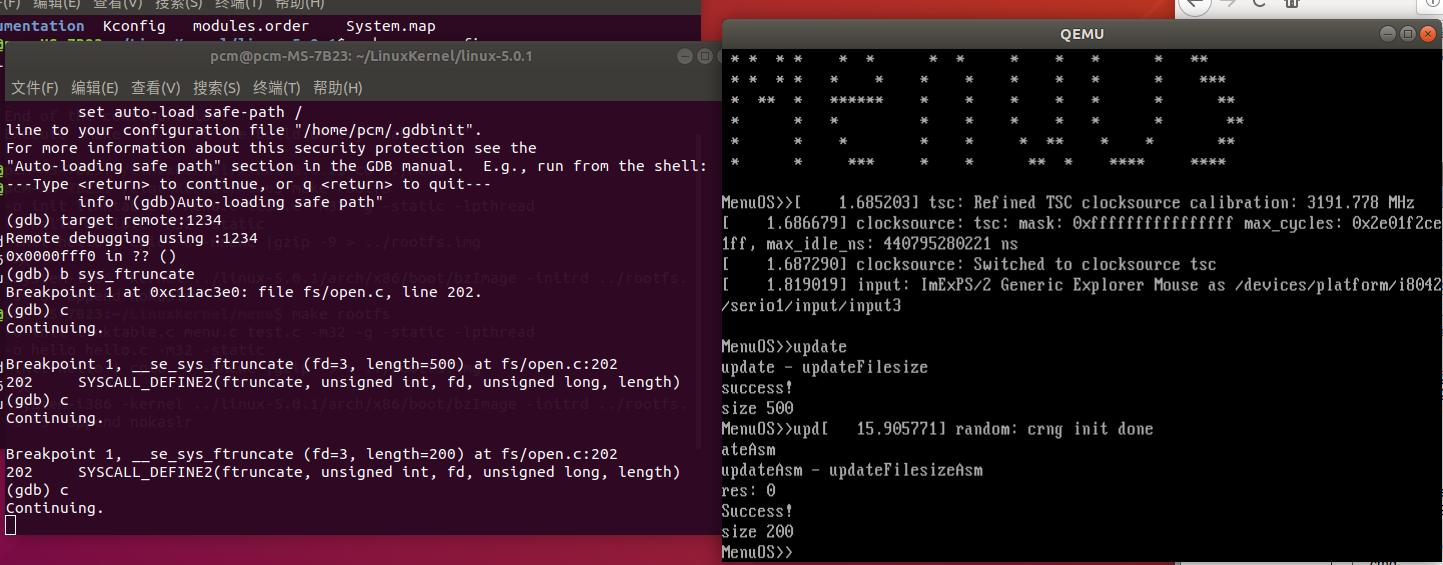
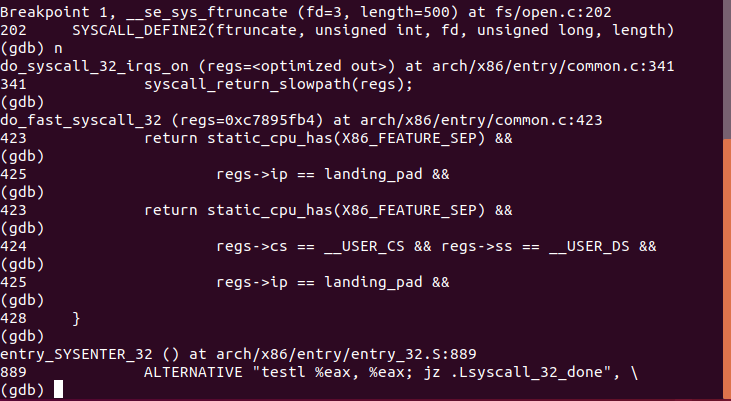
可以看见在使用int 0x80中断之后,CPU会运行arch/x86/entry/entry_32.S中的指令
-
分析entry_32.S代码
#这段代码就是系统调用处理的过程,其它的中断过程也是与此类似 #系统调用就是一个特殊的中断,也存在保护现场和回复现场 ENTRY(system_call) #这是0x80之后的下一条指令 RING0_INT_FRAME # can't unwind into user space anyway ASM_CLAC pushl_cfi %eax # save orig_eax SAVE_ALL #保护现场 GET_THREAD_INFO(%ebp) # system call tracing in operation / emulation testl $_TIF_WORK_SYSCALL_ENTRY,TI_flags(%ebp) jnz syscall_trace_entry cmpl $(NR_syscalls), %eax jae syscall_badsys syscall_call: # 调用了系统调用处理函数,实际的系统调用服务程序 call *sys_call_table(,%eax,4)#定义的系统调用的表,eax传递过来的就是系统调用号,在例子中就是调用的systime syscall_after_call: movl %eax,PT_EAX(%esp) # store the return value syscall_exit: LOCKDEP_SYS_EXIT DISABLE_INTERRUPTS(CLBR_ANY) # make sure we don't miss an interrupt # setting need_resched or sigpending # between sampling and the iret TRACE_IRQS_OFF movl TI_flags(%ebp), %ecx testl $_TIF_ALLWORK_MASK, %ecx # current->work jne syscall_exit_work #退出之前,syscall_exit_work #进入到syscall_exit_work里边有一个进程调度时机 restore_all: TRACE_IRQS_IRET restore_all_notrace: #返回到用户态 #ifdef CONFIG_X86_ESPFIX32 movl PT_EFLAGS(%esp), %eax # mix EFLAGS, SS and CS # Warning: PT_OLDSS(%esp) contains the wrong/random values if we # are returning to the kernel. # See comments in process.c:copy_thread() for details. movb PT_OLDSS(%esp), %ah movb PT_CS(%esp), %al andl $(X86_EFLAGS_VM | (SEGMENT_TI_MASK << 8) | SEGMENT_RPL_MASK), %eax cmpl $((SEGMENT_LDT << 8) | USER_RPL), %eax CFI_REMEMBER_STATE je ldt_ss # returning to user-space with LDT SS #end RESTORE_REGS 4 # skip orig_eax/error_code irq_return: INTERRUPT_RETURN #iret(宏),系统调用过程到这里结束实验总结
其原理是进程先用适当的值填充寄存器,然后调用一个特殊的指令,这个指令会跳到一个事先定义的内核中的一个位置。在Intel CPU中,这个由中断0x80实现。硬件知道一旦你跳到这个位置,你就不是在限制模式下运行的用户,而是作为操作系统的内核--由用户态转为内核态。
进程可以跳转到的内核位置叫做sysem_call。这个过程检查系统调用号,这个号码告诉内核进程请求哪种服务。然后,它查看系统调用表(sys_call_table)找到所调用的内核函数入口地址。接着,就调用函数,等返回后,做一些系统检查,最后返回到进程(或到其他进程,如果这个进程时间用尽)。
进程号是由eax寄存器存储的,参数一般是由ebx、ecx、edx、esl、edl、ebp来存储的。

